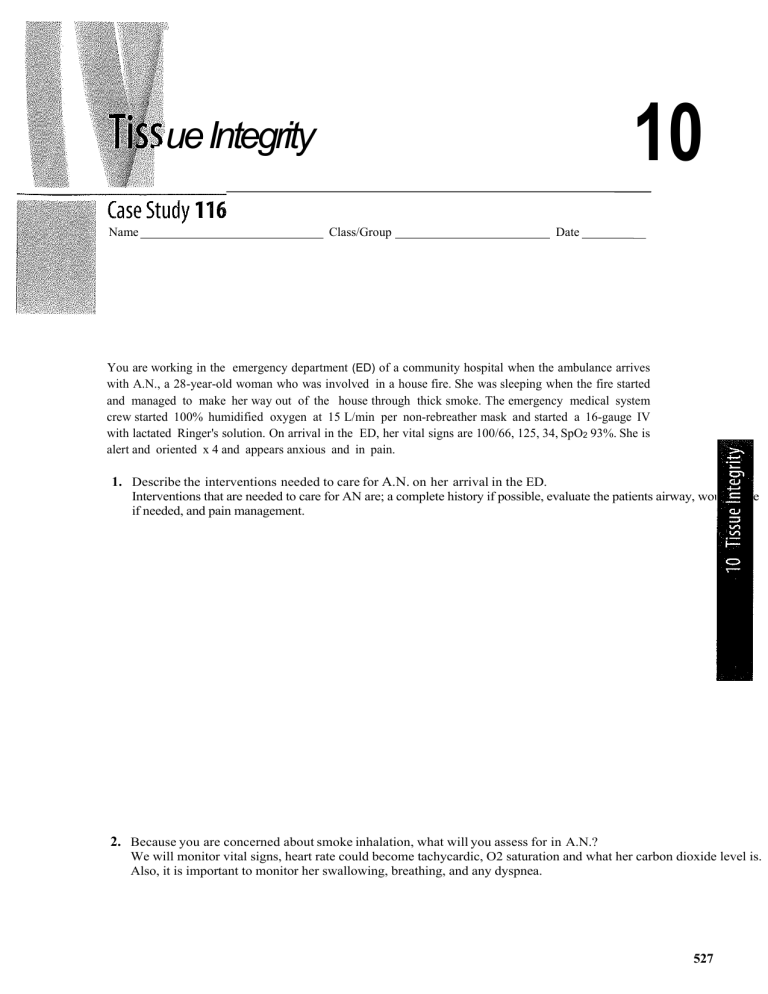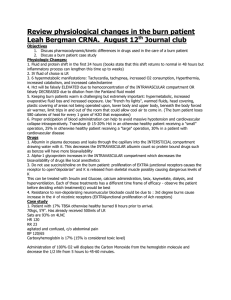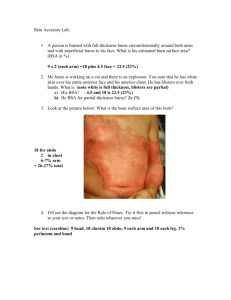
10 ue Integrity Name Class/Group Date _ You are working in the emergency department (ED) of a community hospital when the ambulance arrives with A.N., a 28-year-old woman who was involved in a house fire. She was sleeping when the fire started and managed to make her way out of the house through thick smoke. The emergency medical system crew started 100% humidified oxygen at 15 L/min per non-rebreather mask and started a 16-gauge IV with lactated Ringer's solution. On arrival in the ED, her vital signs are 100/66, 125, 34, SpO2 93%. She is alert and oriented x 4 and appears anxious and in pain. 1. Describe the interventions needed to care for A.N. on her arrival in the ED. Interventions that are needed to care for AN are; a complete history if possible, evaluate the patients airway, wound care if needed, and pain management. 2. Because you are concerned about smoke inhalation, what will you assess for in A.N.? We will monitor vital signs, heart rate could become tachycardic, O2 saturation and what her carbon dioxide level is. Also, it is important to monitor her swallowing, breathing, and any dyspnea. 527 3. As you perform your initial assessment, you note burns on A.N:s right anterior leg, left anterior and posterior leg, and anterior torso. Shade the affected areas, and then, using the rule of nines, calculate the extent of A.N:s burn injury. Modified from lgnatavicius DD, Workman ML: Medical-surgical nursing, ed. 6, St. Louis, 2010, Saunders. 4. You suspect that A.N. has deep partial-thickness burns. Which best describes this type of burn? a. The skin is blackened; the charred sldn is insensitive to pain. b. The wounds are red, blanch, and have accompanying edema. c. The skin is shiny, red, moist, has fluid filled blisters and is painful. d. The wounds are dry, waxy white and hard; burned area has insensitivity to pain. 529 5. Interpret A.N:s lab results. AN’s labs that are increased are the BUN, hct, hgb. CL and NA are decreased while the rest of her labs are remaining normal. 5. A.N. is undergoing burn fluid resuscitation using the standard Baxter (Parkland) formula. She was admitted at 0400. She weighs 154 pounds (70 kg). Calculate her fluid requirements, specify the fluids used in the Baxter (Parkland) formula, specify how much will be given, and indicate what time intervals will be used. 12600mL 6. A.N. is in severe pain. What is the drug of choice for pain relief after burn injury, and how should it be given? To control the severe pain AN should be given acetaminophen, ibuprofen, naproxen to help control the pain. It will likely be given IV for a faster acting response. 530 CASE STUDY PROGRESS A.N. does not show any signs of smoke inhalation injury and is admitted to the medical unit for further treatment. As her nurse, you are concerned about meeting her needs for infection prevention, skin integ­ rity, nutrition, fluids, and psychological support. @ 8. Because of her significant burn injury, A.N. is at high risk for infection. What measures will you institute to prevent infection? Proper hand hygiene is going to be the number one concept to complete and understand, another concept is keep sterile technique when needed. 531 9. A.N’s burns are being treated by the open method with topical application of silver sulfadiazine. In caring for A.N., which interventions will you perform? Select all that apply. a. Shave all hair within the wound beds b. Keep the room temperature at 85° F (29.4° C) c. Use clean technique when changing A.N:s dressings d. Monitor the CBC and WBC with differential frequently e. Apply a ½,-inch (1.5 mm) film of medication, covering entire burn f. Do not allow her to bathe for the initial 72 hours after injury 10. A.N. has one area of circumferential burns on her right lower leg. What complication is she in danger of developing? How will you monitor for it? The complications that AN is are risk for are decreased profusion to the lower extremities. Meaning that we will want to monitor for foot color, warmth, sensation level, swelling and pain level. Compartment syndrome can happen in our burn patients. 11. Describe 4 interventions that will help promote A.N:s peripheral tissue perfusion. 4 interventions that will help promote perfusion is stretching, repositioning, use a circulating air bed, and lastly, keeping the covers off the burnt area. 12. A.N. is ordered a special burn diet. She has always gained weight easily and is concerned about the size of the portions. What diet-related teaching will you provide? The teaching that I would want to provide is extra protein, high calorie foods, and in between meal snacks. 13. List 6 interventions you can use to assist in meeting A.N’s nutrition goals. Eat nutrient rich foods, snack between meals, calculate calories, increase fluid intake, maybe even take medications that help stimulate appetite, and rest. 532 14. Tissues under and around A.N’s burns are severely swollen. She looks at you with tears in her eyes and asks, "Will they staythis way?" What is your answer? The tissue should not stay that way. The important thing to understand is that once the capillaries repair, the swelling will decrease. 15. A.N. is concerned about visible scars. What will you tell her? We can let AN know that she may have those scars, but those scars can decrease in color over time as the tissue heals. Chart View •-----wn • ww, •, ••n•• •na , Vital Signs 90/50 BP Heart rate Respiratory rate 130 Temperature 99.0° F (37.2° CJ 24 CASE STUDY PROGRESS Eighteen hours after the injury, the UAP reports these vital signs and states A.N:s urine output for the past 2 hours was 40 ml. 16. What do you suspect is occurring, and why does this concern you? AN could be in renal insufficiency which can lead to renal failure if not handled properly. 17. What treatment do you expect? I would anticipate that patient might be put on some form of fluid replacement therapy. Chart View Laboratory Test Values Hgb Hct K Na Cl Glucose BUN Creatinine 24 g/ dL (240 g/L) 59% 5.3 mEq/Dl (5.3 mmol/L) 128 mEq/Dl (128 mmol/L) 92 mEq/Dl (92 mmol/L) 122 mg/dL (6.8 mmol/L) 38 mg/dL (13.6 mmol/L) 1.9 mg/dL (168 mcmol/L) 533 18, The provider increases A.N’e Study s IV rate and orders a new set of lab work. Compare the current results with those from admission. Hct, Bun, Creatinine, and potassium are elevated, because of the risk for dehydration. 19, By the end of your shift, which assessment findings would best indicate that A.N. is responding to therapy? a. Respiratory rate 22; BP 120/74 b. BP 120/70; urine output 25 mL/hr for past 4 hours c. BP 104/64; urine output 40 mL/hr for past 4 hours d. Heart rate 110; urine output 20 mL/hr for past 4 hours CASE STUDY OUTCOME Four days after her injury, A.N. begins a formal rehabilitation program and is able to maintain full range of motion and tissue mobility. Her recovery is prolonged by two wound infections, and she does experience some scarring. One year later she is still struggling with adapting to her new body image, but she is find­ ing encouragement from family, friends, and her support group. 534





